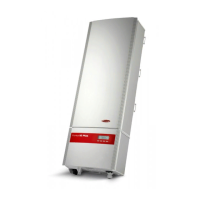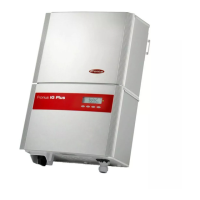Do you have a question about the Fronius IG 2000 and is the answer not in the manual?
General instructions for installation and maintenance of the inverter, emphasizing safety precautions.
Explanation of warning symbols and descriptions of hazards to equipment or personnel.
Requirements for electrical installations, referencing National Electrical Code and Canadian standards.
Information on inverter safety features including galvanic isolation and grid monitoring.
Explanation of the high-frequency transformer ensuring galvanic isolation between DC side and grid.
How the inverter monitors grid conditions and stops operation if inconsistent.
Device compliance with FCC rules, including conditions for operation and interference.
Description of the inverter's role as a link between solar modules and the public grid.
Overview of inverter installation and connection, including safety, diagrams, and options.
Details on various knockouts for conduit fittings and connection points on the inverter.
Guidelines for selecting suitable indoor and outdoor installation locations for the inverter.
Instructions for physical mounting of the inverter, including screws and height considerations.
Steps for connecting the inverter to the AC disconnect and grounding, including grid configuration.
Guidelines for connecting solar module strings to the inverter, including safety and DC terminal details.
Overview of the inverter's controls, indicators, display, LEDs, and keys.
Explanation of the function, colors, and status indications of the Operating and GFDI LEDs.
Detailed steps of the inverter's startup process, self-test, grid synchronization, and feed-in mode.
Instructions on activating display illumination and accessing the inverter's menu level.
Description of available display modes ('Now', 'Day', 'Year', 'Total') and how to select them.
Introduction to the setup menu for readjusting inverter parameters and accessing settings.
How the inverter's self-diagnostic system identifies and displays operational issues and status codes.
Explanation of status codes that appear during normal operation, such as low solar module voltage.
Troubleshooting steps for when the inverter display remains dark after sunrise.
Procedure when a ground fault occurs in the DC cabling, leading to grid disconnection.
Temporary status codes related to public grid conditions and their remedies.
Temporary status codes related to grid voltage and frequency variations and their remedies.
Status codes that may appear during feed-in but do not cause permanent interruption.
Status codes that may require intervention from a trained Fronius service technician.
Information on contacting Fronius dealers or service technicians for errors and support.
Detailed input, output, and general data specifications for the Fronius IG 2000 model.
Detailed input, output, and general data specifications for the Fronius IG 3000 model.
Detailed input, output, and general data specifications for the Fronius IG 2500-LV model.
Detailed input, output, and general data specifications for the Fronius IG 4000 model.
Detailed input, output, and general data specifications for the Fronius IG 5100 model.
Detailed input, output, and general data specifications for the Fronius IG 4500-LV model.
Table of adjustable trip points for voltage and frequency parameters at different voltage levels.
Information on warranty terms, conditions, and how to register the product for full coverage.
Instructions for the proper recycling and disposal of obsolete Fronius inverters.
General instructions for installation and maintenance of the inverter, emphasizing safety precautions.
Explanation of warning symbols and descriptions of hazards to equipment or personnel.
Requirements for electrical installations, referencing National Electrical Code and Canadian standards.
Information on inverter safety features including galvanic isolation and grid monitoring.
Explanation of the high-frequency transformer ensuring galvanic isolation between DC side and grid.
How the inverter monitors grid conditions and stops operation if inconsistent.
Device compliance with FCC rules, including conditions for operation and interference.
Description of the inverter's role as a link between solar modules and the public grid.
Overview of inverter installation and connection, including safety, diagrams, and options.
Details on various knockouts for conduit fittings and connection points on the inverter.
Guidelines for selecting suitable indoor and outdoor installation locations for the inverter.
Instructions for physical mounting of the inverter, including screws and height considerations.
Steps for connecting the inverter to the AC disconnect and grounding, including grid configuration.
Guidelines for connecting solar module strings to the inverter, including safety and DC terminal details.
Overview of the inverter's controls, indicators, display, LEDs, and keys.
Explanation of the function, colors, and status indications of the Operating and GFDI LEDs.
Detailed steps of the inverter's startup process, self-test, grid synchronization, and feed-in mode.
Instructions on activating display illumination and accessing the inverter's menu level.
Description of available display modes ('Now', 'Day', 'Year', 'Total') and how to select them.
Introduction to the setup menu for readjusting inverter parameters and accessing settings.
How the inverter's self-diagnostic system identifies and displays operational issues and status codes.
Explanation of status codes that appear during normal operation, such as low solar module voltage.
Troubleshooting steps for when the inverter display remains dark after sunrise.
Procedure when a ground fault occurs in the DC cabling, leading to grid disconnection.
Temporary status codes related to public grid conditions and their remedies.
Temporary status codes related to grid voltage and frequency variations and their remedies.
Status codes that may appear during feed-in but do not cause permanent interruption.
Status codes that may require intervention from a trained Fronius service technician.
Information on contacting Fronius dealers or service technicians for errors and support.
Detailed input, output, and general data specifications for the Fronius IG 2000 model.
Detailed input, output, and general data specifications for the Fronius IG 3000 model.
Detailed input, output, and general data specifications for the Fronius IG 2500-LV model.
Detailed input, output, and general data specifications for the Fronius IG 4000 model.
Detailed input, output, and general data specifications for the Fronius IG 5100 model.
Detailed input, output, and general data specifications for the Fronius IG 4500-LV model.
Table of adjustable trip points for voltage and frequency parameters at different voltage levels.
Information on warranty terms, conditions, and how to register the product for full coverage.
Instructions for the proper recycling and disposal of obsolete Fronius inverters.











